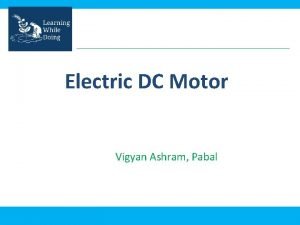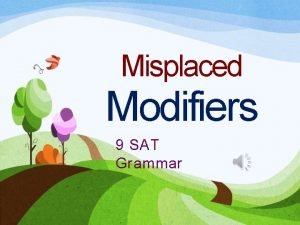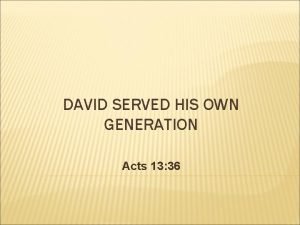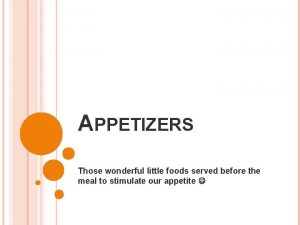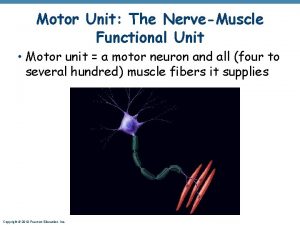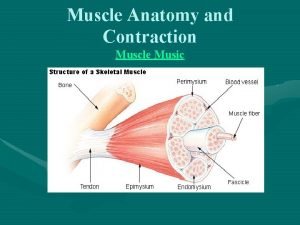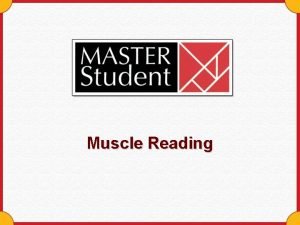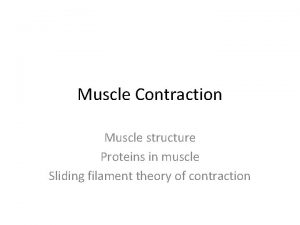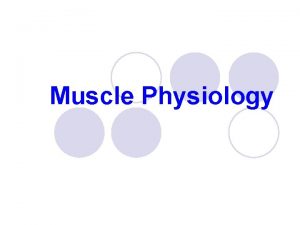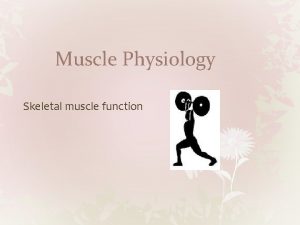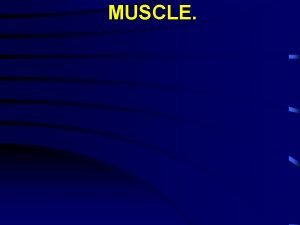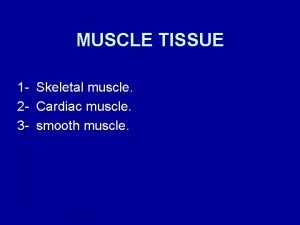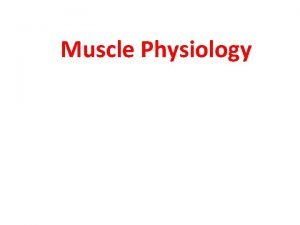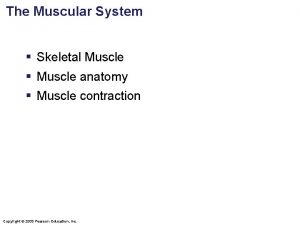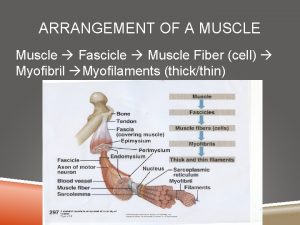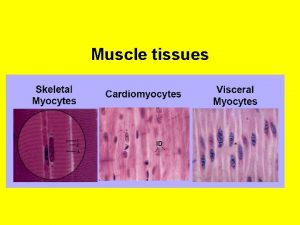Motor Unit NerveMuscle Functional Unit Each muscle served


















- Slides: 18

Motor Unit: Nerve-Muscle Functional Unit • Each muscle served by at least one motor nerve – Motor nerve contains axons of up to hundreds of motor neurons – Axons branch into terminals, each of which NMJ with single muscle fiber © 2013 Pearson Education, Inc.

Figure 9. 13 A motor unit consists of one motor neuron and all the muscle fibers it innervates. Spinal cord Motor unit 1 Motor unit 2 Axon terminals at Branching axon neuromuscular junctions to motor unit Nerve Motor neuron cell body Motor neuron axon Muscle fibers Axons of motor neurons extend from the spinal cord to the muscle. There each axon divides into a number of axon terminals that form neuromuscular junctions with muscle fibers scattered throughout the muscle. © 2013 Pearson Education, Inc. Branching axon terminals form neuromuscular junctions, one per muscle fiber (photomicrograph 330 x).

Motor Unit • Motor unit = motor neuron and all (four to several hundred) muscle fibers it supplies – Smaller number = fine control • Motor units in muscle usually contract asynchronously; helps prevent fatigue © 2013 Pearson Education, Inc.

Figure 9. 15 a A muscle's response to changes in stimulation frequency. Tension Single stimulus Contraction single twitch Maximal tension of a single twitch Relaxation 0 Stimulus 100 Time (ms) 200 300 A single stimulus is delivered. The muscle contracts and relaxes. © 2013 Pearson Education, Inc.

Figure 9. 15 b A muscle's response to changes in stimulation frequency. Tension Low stimulation frequency unfused (incomplete) tetanus Partial relaxation Stimuli 0 100 Time (ms) 200 300 If another stimulus is applied before the muscle relaxes completely, then more tension results. This is wave (or temporal) summation and results in unfused (or incomplete) tetanus. © 2013 Pearson Education, Inc.

Figure 9. 15 c A muscle's response to changes in stimulation frequency. fused (complete) tetanus Tension High stimulation frequency Stimuli 0 100 Time (ms) 200 300 At higher stimulus frequencies, there is no relaxation at all between stimuli. This is fused (complete) tetanus. © 2013 Pearson Education, Inc.

Response to Change in Stimulus Strength • Recruitment (motor unit summation) controls force of contraction • Threshold stimulus: stimulus strength causing first observable muscle contraction • Maximal stimulus – strongest stimulus that increases contractile force © 2013 Pearson Education, Inc.

Stimulus voltage Figure 9. 16 Relationship between stimulus intensity (graph at top) and muscle tension (tracing below). Stimulus strength Maximal stimulus Threshold stimulus 1 2 3 4 7 5 6 Stimuli to nerve 8 9 10 Proportion of motor units excited Strength of muscle contraction Tension Maximal contraction © 2013 Pearson Education, Inc. Time (ms)

Response to Change in Stimulus Strength • Recruitment works on size principle – Motor units with smallest muscle fibers recruited first – Motor units with larger and larger fibers recruited as stimulus intensity increases – Largest motor units activated only for most powerful contractions © 2013 Pearson Education, Inc.

Tension Figure 9. 17 The size principle of recruitment. Skeletal muscle fibers Time Motor unit 1 recruited (small fibers) © 2013 Pearson Education, Inc. Motor unit 2 recruited (medium fibers) Motor unit 3 recruited (large fibers)

Isotonic Contractions • Isotonic contractions either concentric or eccentric: – Concentric contractions—muscle shortens and does work – Eccentric contractions—muscle generates force as it lengthens © 2013 Pearson Education, Inc.

Muscle Tone • Constant, slightly contracted state of all muscles • Due to spinal reflexes – Groups of motor units alternately activated in response to input from stretch receptors in muscles • Keeps muscles firm, healthy, and ready to respond © 2013 Pearson Education, Inc.

Muscle Metabolism: Energy for Contraction • ATP only source used directly for contractile activities • Stores of ATP depleted in 4– 6 seconds © 2013 Pearson Education, Inc.

Muscle Metabolism: Energy for Contraction • ATP regenerated by: – Phosphorylation of ADP by creatine phosphate (CP) – Anaerobic pathway (glycolysis lactic acid) – Aerobic respiration © 2013 Pearson Education, Inc.

Figure 9. 19 a Pathways for regenerating ATP during muscle activity. Direct phosphorylation Coupled reaction of creatine Phosphate (CP) and ADP Energy source: CP Creatine kinase Creatine Oxygen use: None Products: 1 ATP per CP, creatine Duration of energy provided: 15 seconds © 2013 Pearson Education, Inc.

Anaerobic Pathway • Glycolysis – does not require oxygen – Glucose degraded to 2 pyruvic acid molecules • Normally enter mitochondria aerobic respiration • At 70% of maximum contractile activity – Bulging muscles compress blood vessels; oxygen delivery impaired – Pyruvic acid converted to lactic acid © 2013 Pearson Education, Inc.

Figure 9. 19 b Pathways for regenerating ATP during muscle activity. Anaerobic pathway Glycolysis and lactic acid formation Energy source: glucose Glucose (from glycogen breakdown or delivered from blood) Glycolysis in cytosol 2 net gain Released to blood Pyruvic acid Lactic acid Oxygen use: None Products: 2 ATP per glucose, lactic acid Duration of energy provided: 30 -40 seconds, or slightly more © 2013 Pearson Education, Inc.

Figure 9. 19 c Pathways for regenerating ATP during muscle activity. Aerobic pathway Aerobic cellular respiration Energy source: glucose; pyruvic acid; free fatty acids from adipose tissue; amino acids from protein catabolism Glucose (from glycogen breakdown or delivered from blood) Fatty acids Amino acids Pyruvic acid Aerobic respiration in mitochondria 32 net gain per glucose Oxygen use: Required Products: 32 ATP per glucose, CO 2, H 2 O Duration of energy provided: Hours © 2013 Pearson Education, Inc.
 A motor unit consists of a motor neuron and
A motor unit consists of a motor neuron and Gap junction in smooth muscle
Gap junction in smooth muscle Toe dancers muscle a two bellied muscle of the calf
Toe dancers muscle a two bellied muscle of the calf Mmt grading sullivan
Mmt grading sullivan Space maintainer types
Space maintainer types Non functional plasma enzyme
Non functional plasma enzyme Functional and non functional plasma enzymes
Functional and non functional plasma enzymes Functional and non functional
Functional and non functional Pony motor starting method diagram
Pony motor starting method diagram What is hunting in synchronous motor
What is hunting in synchronous motor Ac motor vs dc motor
Ac motor vs dc motor Pony motor starting synchronous motor
Pony motor starting synchronous motor Solar system inner and outer planets
Solar system inner and outer planets Activism period in philippine literature
Activism period in philippine literature Modifier placement sat
Modifier placement sat When david has served his generation
When david has served his generation Small open faced sandwiches served as appetizer
Small open faced sandwiches served as appetizer Assisted service restaurant
Assisted service restaurant Crew served weapons qualification
Crew served weapons qualification










